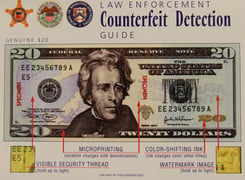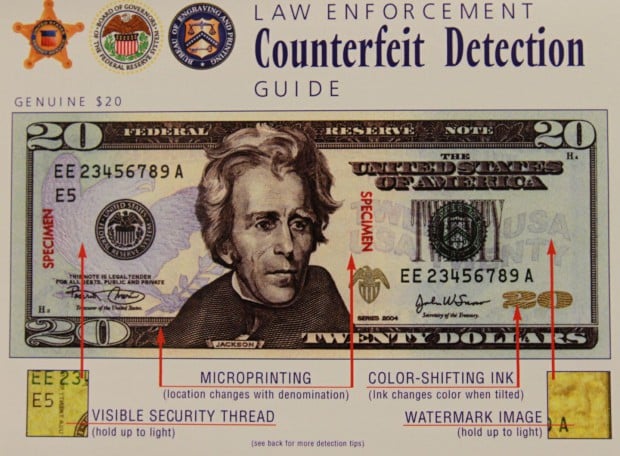 Counterfeit money damages the U.S. economy and can substantially impact businesses of all industries. Through the end of 2013, as much as $103 million in counterfeit U.S. currency has been smuggled into the United States from South America. Peru is of particular concern. Because of the involvement of the drug cartels in the industry, counterfeiting has become a professional occupation with journeyman counterfeiters that have driven the Peruvian counterfeits to previously-unseen levels of quality. Of all denominations, in the United States, the $20 bill is the most commonly counterfeited.
Counterfeit money damages the U.S. economy and can substantially impact businesses of all industries. Through the end of 2013, as much as $103 million in counterfeit U.S. currency has been smuggled into the United States from South America. Peru is of particular concern. Because of the involvement of the drug cartels in the industry, counterfeiting has become a professional occupation with journeyman counterfeiters that have driven the Peruvian counterfeits to previously-unseen levels of quality. Of all denominations, in the United States, the $20 bill is the most commonly counterfeited.
What can you do to protect yourself or your business against counterfeit money? Fortunately, there are several distinguishing characteristics of genuine U.S. currency that counterfeit detectors use to catch discrepancies that are undetectable to the naked eye. Here are some key security features in the $20 bill that counterfeit currency producers try to mimic:
Color-Shifting Ink
The numeral “20” in the lower right hand corner of the front of a US $20 bill shifts from copper to green when tilted. Though color-shifting ink can be difficult to reproduce, skilled counterfeiters can mimic this quality. Therefore, the presence of color-shifting ink does not independently guarantee that currency is genuine.

Microprinting
• "USA20" next to security thread
• "THE UNITED STATES OF AMERICA 20 USA 20" below the Treasurer's signature
Microprinting is difficult to reproduce without very expensive, quality printers, but unfortunately, many counterfeiters have made the investment. Most of the serious counterfeiters use off-set printers which are similar to printers on which genuine dollars are printed and are able to reproduce these effects.
Also, consider what steps are necessary to authenticate microprinting. Really, a magnifying glass is required. Imagine the effect on your customers if your cashiers were bent over the notes with a magnifier every time they take a US banknote!
Watermark
When held up to light, you can see a watermark of Andrew Jackson on $20 bills. The watermark is embossed in the paper that the bill was printed on, so it can be seen from both sides. Some counterfeit bills may make use of watermark-printing applications available on many digital printers these days. These counterfeits may have the image faintly printed instead of watermarked.
Other counterfeiters may use a technique that (somewhat) bypasses the watermark problem. They "wash" $5 bills (which have watermarks) to extract the ink and then print $20 over the blank $5 bill paper. This technique can make strikingly similar bills that look and feel real. However, if you look closely, the a phony $20 washed from a $5 has the watermark of Abraham Lincoln instead of Andrew Jackson.

Security Thread
Each $20 bill produced after 2003 contains a plastic strip embedded along its left hand side. When held up to the light you can see “USA TWENTY” and an American flag. Moreover, when placed under ultraviolet light from a counterfeit detector, the security thread glows in green. Unfortunately, criminals have found a way to replicate security strips. Counterfeiters in Peru are so detailed that they have developed a technique to duplicate the security strip. They thread a bogus security strips into the bills by hand with the aid of a needle, and then secure it using glue dispensed by a medical syringe.
Color and location of UV Security Strips on US Dollar Notes

Color and Paper
Unlike older versions, new $20’s contains green, peach, and blue ink in their background. It is also important that there are small blue and red microfibers embedded in the paper. These blue and red fibers are not printed on the surface of the note, but are an integral part of the paper. Counterfeit for older bills bypass this problem using the money washing technique described earlier, while others use recycled paper from newspaper and couple this with off-set printing technology.
Final Thoughts
It can be nearly impossible to spot high quality counterfeit currency using only your eyes because many counterfeiters have honed their craft and are able to meticulously create reasonable facsimiles of the real-thing. Fortunately, counterfeit detectors employ comprehensive analytical techniques that even "supernotes" can't fool to ensure the authenticity of your bills. If you want to protect your business and have peace of mind that every bill you receive is genuine, you should invest in a counterfeit detector that fits the requirements of your unique transaction environment.



